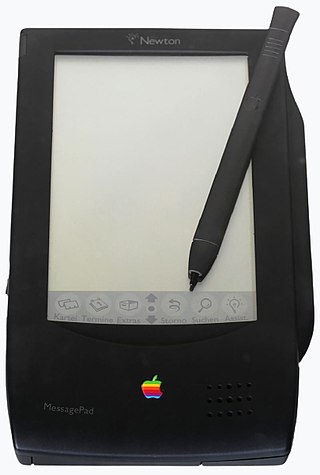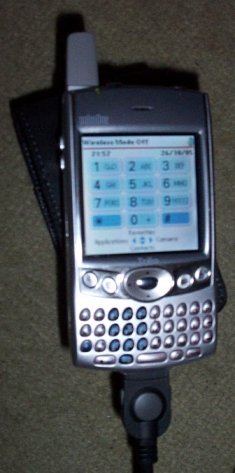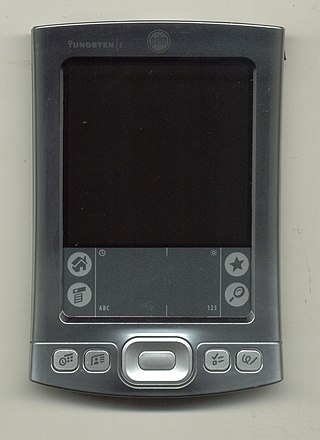Related Research Articles

The MessagePad was a series of personal digital assistant devices developed by Apple Computer for the Newton platform in 1993. Some electronic engineering and the manufacture of Apple's MessagePad devices was undertaken in Japan by Sharp. The devices are based on the ARM 610 RISC processor and all featured handwriting recognition software and were developed and marketed by Apple. The devices run Newton OS.

A personal digital assistant (PDA) is a multi-purpose mobile device which functions as a personal information manager. By 2007, PDAs have been mostly displaced by the widespread adoption of more highly capable smartphones, in particular those based on iOS and Android, and thus saw a rapid decline afterwards.

Palm OS was a mobile operating system initially developed by Palm, Inc., for personal digital assistants (PDAs) in 1996. Palm OS was designed for ease of use with a touchscreen-based graphical user interface. It was provided with a suite of basic applications for personal information management. Later versions of the OS were extended to support smartphones. The software appeared on the company's line of Palm devices while several other licensees have manufactured devices powered by Palm OS.

Palm, Inc., was an American company that specialized in manufacturing personal digital assistants (PDAs) and developing software. Palm designed the PalmPilot, the first PDA successfully marketed worldwide, and was known for the Treo 600, one of the earlier successful smartphones. Palm developed the Palm OS software for PDAs and smartphones released under its line of Palm-branded devices and also licensed to other PDA manufacturers.

Palm is a now discontinued line of personal digital assistants (PDAs) and mobile phones developed by California-based Palm, Inc., originally called Palm Computing, Inc. Palm devices are often remembered as "the first wildly popular handheld computers," responsible for ushering in the smartphone era.

Handwriting recognition (HWR), also known as handwritten text recognition (HTR), is the ability of a computer to receive and interpret intelligible handwritten input from sources such as paper documents, photographs, touch-screens and other devices. The image of the written text may be sensed "off line" from a piece of paper by optical scanning or intelligent word recognition. Alternatively, the movements of the pen tip may be sensed "on line", for example by a pen-based computer screen surface, a generally easier task as there are more clues available. A handwriting recognition system handles formatting, performs correct segmentation into characters, and finds the most possible words.

Graffiti is an essentially single-stroke shorthand handwriting recognition system used in PDAs based on the Palm OS. Graffiti was originally written by Palm, Inc. as the recognition system for GEOS-based devices such as HP's OmniGo 100 and 120 or the Magic Cap-line and was available as an alternate recognition system for the Apple Newton MessagePad, when NewtonOS 1.0 could not recognize handwriting very well. Graffiti also runs on the Windows Mobile platform, where it is called "Block Recognizer", and on the Symbian UIQ platform as the default recognizer and was available for Casio's Zoomer PDA.

Treo 600 was a smartphone developed by Handspring, and offered under the palmOne brand after the merger of the two companies. Released in November 2003, it has a number of integrated features and it is possible to check the calendar while talking on the phone, dial directly from contacts list, take pictures or send emails. It includes a five-way navigation button and favorites screen allowing quick access to the phone functions.

The Tungsten series was Palm, Inc.'s line of business-class Palm OS-based PDAs.
The Samsung SPH-i500 was a Palm OS-based smartphone manufactured by Samsung Electronics. It was previewed at CommunicAsia 2002 in June and launched later that year. It was later discontinued in August 2005. It was marketed in the United States for use on Sprint's mobile phone network.

The Palm Treo is a discontinued line of smartphones originally developed by Handspring, which was bought by Palm, Inc. They were then manufactured and maintained by Palm, Inc. Treos had a number of integrated features such as the ability to check the calendar while talking on the phone, dial directly from a list of contacts, and send email messages. The final models included a built-in camera. Treos ran Palm OS, but later models also ran Windows Mobile. The Palm Pre, released in June 2009, replaced the Treo series.
Donna Dubinsky is an American businesswoman who played a role in the development of personal digital assistants (PDAs), as CEO of Palm, Inc. and co-founding Handspring with Jeff Hawkins in 1995. Dubinsky co-founded Numenta in 2005 with Hawkins and Dileep George, based in Redwood City, CA. Numenta was founded to develop machine intelligence based on the principles of the neocortex. Dubinsky is CEO and chair of Numenta. Dubinsky is also on the board of Twilio. She was on the board of Yale University from 2006–2018, including two years as senior trustee.

Blazer was a web browser available for Palm handhelds running Palm OS 3.1 or higher.
The Treo 180 is a dual-band GSM smartphone made by Handspring. Released in 2002, it was the first device in the Treo family. Internet access was available using the Blazer browser.

The Palm Treo 700p is a cell phone with advanced capabilities, commonly referred to as a smartphone. Unlike the slightly earlier Treo 700w, this model is based on Palm OS. This is the first Palm OS-based Treo model to feature high-speed cellular network support, and is also the first Treo model to support Bluetooth 1.2.

The Treo 90 is a Palm OS PDA developed by Handspring. It was released on May 28, 2002. The Treo 90 was the only Treo model produced without an integrated cellular phone. When first released it was the smallest Palm OS device on the market.
Handspring, Inc., was an American electronics company founded in 1998 by the founders of Palm, Inc., after they became dissatisfied with the company's direction under the new owner 3Com. The company developed Palm OS–based Visor- and Treo-branded personal digital assistants. In 2003, the company merged with Palm, Inc.'s hardware division.

The Treo 270 was a dual-band GSM flip form factor smartphone made by Handspring. Released on May 31, 2002 for $499 with service contract, $699 without service contract, it was the fourth device in the Treo family. It featured a full keyboard and shipped with Palm OS version 3.5.2H. The 270 had a 160×160 color screen, 16 MB of internal memory and a 33 MHz DragonBall CPU.

The Fossil Wrist PDA is a smartwatch that runs Palm OS. The newer incarnation, which does not include Palm OS, is called the Fossil WristNet watch.
References
- ↑ "Handspring Treo 180, 180g, 270 Coming in 2002". www.palminfocenter.com. Retrieved 2023-10-23.
- ↑ "Pen Computing Magazine: Handspring Treo 180/180g". pencomputing.com. Retrieved 2023-10-23.